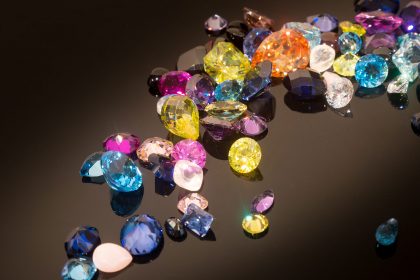How to Clean Your Gemstone Jewelry

What do you need to clean your gemstone jewelry? For many pieces, mild detergent, warm water, and a soft brush are a good start. If you have any doubts, make sure that you email and ask us.
Before You Start Cleaning, Know Your Gemstones
Have the gemstones in your jewelry been properly identified? Different gemstones have different physical properties. That means they can react very differently to heat, light, acids, and scratching.
A High Hardness Doesn’t Mean a Gem Resists All Types of Exposure
Don’t assume a gem’s resistance to one type of exposure is the same for all types of exposure. Hardness is a commonly referenced physical quality for gemstones, and those that rank high on the Mohs scale, such as diamonds, rubies, and sapphires, are prized choices for jewelry. However, a high Mohs score doesn’t make the gemstone indestructible. Hardness is the ability to resist scratching and nothing more. For example, diamonds have the greatest hardness of any natural material. However, they can have inclusions and incipient cleaves that might have unfortunate reactions to heat or mechanical cleaning.
Gem Treatments and Enhancements
Gemstone treatments can enhance appearance but can also negatively interact with some cleaning processes. For example, gem merchants sometimes fill tiny fractures in emerald gems with oils. This improves the emeralds’ transparency. However, exposing an oil-treated emerald to heat or an ultrasonic cleaning could damage it.
Get a Professional Gem Identification and Appraisal
Knowing your collection is the critical first step to choosing the best cleaning method. Reputable jewelers should provide information about the gems you purchase. Gemologists can accurately identify your gems as well as any treatments they’ve received. They can also assess the unique inclusions and physical quirks of individual gems you possess that might impact their care. The International Gem Society lists recommended gem identification laboratories and appraisal services.
Recommendations For At-Home Gemstone Jewelry Cleaning
Once you’ve identified your gems, consult our gemstone care guide for how to clean your jewelry. If cleaning with mild detergent at home is the best course of action, here are some recommendations:
- Most commercially prepared jewelry cleaners are safe, but beware of those that contain ammonia or chemicals that can damage sensitive gems like pearl or amber.
- As a first step, let your jewelry piece soak for a few moments in a solution of warm water and mild detergent or cleaning solution.
- Use a soft brush, not a toothbrush, to gently scrub your jewelry.
- A shaved matchstick or toothpick is quite good at picking out accumulations, but don’t be too harsh. Patience pays off.
- When you’ve finished scrubbing, dip the jewelry piece back into the solution for one last wetting. Then rinse in warm running water, preferably about the same temperature as your solution. Radical temperature changes are dangerous and should be avoided.
- Shake or blow on the jewelry piece to remove excess liquid, then gently polish with a soft lint-free cloth or chamois.
- Here’s a jeweler’s trick to avoid any liquid stains on a gem or precious metal setting. Dispense with the cloth and immerse the jewelry piece in a bed of dry maple wood chips. Once dry, blow away the chips. The piece will be of water spots. The wood chip technique works best for large gems.
Take Special Care of Faceted Gem Settings
Familiarize yourself with the various types of gem facets and their functions.
To get transparent faceted gemstones to look their best, the pavilion facets below the girdle of the gem need to be cleaned carefully. These facets play a critical role in gemstone dispersion, the beautiful reflection of colors. Unfortunately, dirt tends to accumulate on the underside of a gem.
The prongs of a jewelry setting can make the pavilion difficult to reach. Furthermore, some gem setters may not smooth out notches they cut into the prongs, making them prime repositories for dirt. Be especially watchful cleaning around the prongs. A fine camel hair artist’s brush is highly recommended for getting at the pavilions and the prongs.
Caring For Your Gemstone Jewelry Before You Clean
Cleaning your gemstones after they get dirty is only part of proper care. Pre-use care is also important. Apply your perfumes, colognes, and hairsprays before you put on gemstone jewelry. Not only will these chemicals reduce gem brilliance, the ability to return light, they can be highly destructive to some gems, such as pearls, which react violently to acid and alcohol.
If possible, wear your perfumes and colognes in areas that won’t come in contact with your gems. In the case of pearls, try to keep them out of contact with skin, whether you’re wearing perfume or not. Perspiration is inimical to pearls. If it’s impossible to keep your pearls away from your skin (if they’re on chokers or bracelets, for example), wipe them clean with a damp cloth immediately after wearing them.
(From the International Gem Society)
